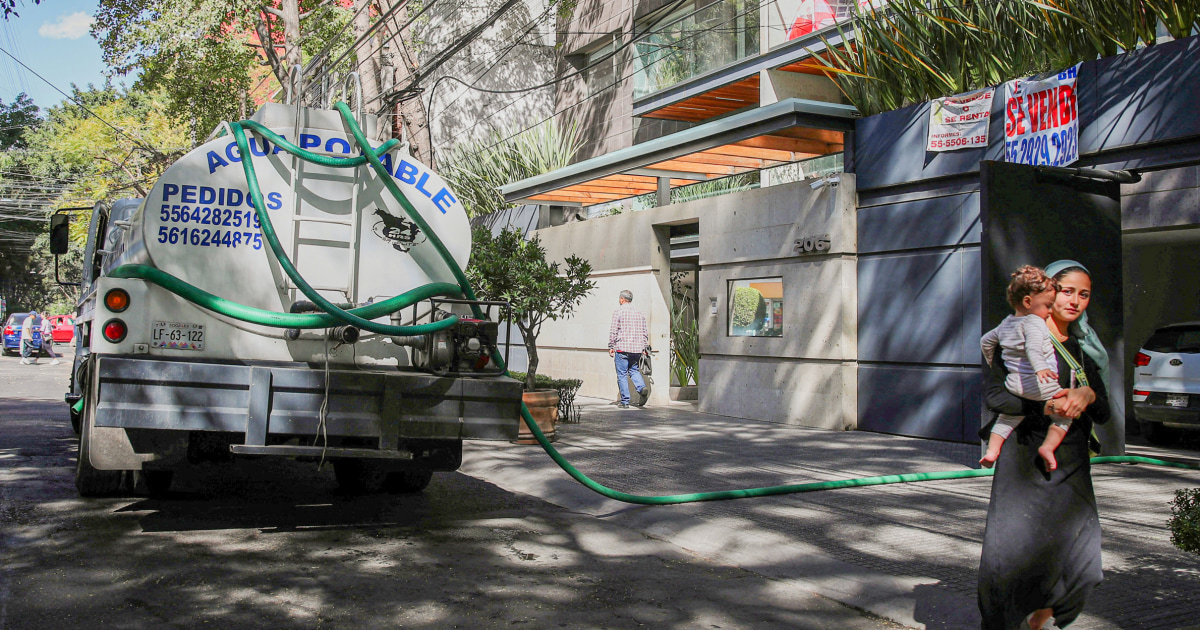By Denise Chow (
NBC News
)
and Albinson Linares (Noticias Telemundo)
The most populated city in North America is suffering a serious crisis due to lack of water.
Persistent drought and years of low rainfall have brought Mexico City's already limited tap water supply system to the brink of collapse, and more than 21 million people have been suffering from rationing for weeks with reservoirs at historically low levels. .
Olga González, 50, a resident of the Coyoacán neighborhood, explained that local authorities use tanker trucks to supply water to residents in the area, but it is simply not enough.
A woman walks near a water tanker truck in Mexico City, January 26, 2024. Henry Romero / Reuters
“Sometimes the trucks take four or five days to arrive,” he said.
The shortage forces González to do everything possible with the little water available.
“I recycle water.
“I get in the shower and collect the water to use in the toilet,” he explains, “and the same with the washing machine.
“I recycle the water from the wash cycle to use in the toilet.”
In addition, he has to buy drinking water in stores because the one supplied by the city
It's too dirty and chlorinated to drink.
In the Tlalpan borough of Mexico City, Nancy Cabrera Cepeda, a 40-year-old office worker, explains that local authorities usually provide water to residents only once a week.
“We have a tank and, when the water arrives, it fills, but in general we do not have supply,” he added.
Unfortunately, shortages have become a familiar problem in Mexico City, where poorly planned urban development, insufficient infrastructure, and history and geography are taking a critical toll on the region's water system.
In recent years, drought, exacerbated by the climate crisis, has worsened these problems.
“Last year we spent two months without water,” says Estela Hernández Villa, a 42-year-old merchant from the Iztapalapa delegation, “there are areas that go even longer.”
Darío Solano Rojas, an engineering professor at the National Autonomous University of Mexico, sees it as unlikely that the entire city will run out of water—a milestone sometimes called “day zero”—but says the coming months will likely be difficult.
“If I run out of water, for me it's day zero,” he says, “this kind of thing has been happening for a long time.”
Several people fill boats with water from a tanker truck in Mexico City, January 26, 2024.Henry Romero / Reuters
The region's complicated relationship with water is as old as the city itself, which sits on the bed of a high-altitude lake that was drained in the 16th century following the Spanish invasion.
The city's main source of water thus comes from pumping underground aquifers and channeling a network of canals, dams and reservoirs that make up the Cutzamala System.
Approximately 70% of Mexico City's water is pumped from underground, while the Cutzamala System supplies the remaining 30% to the Mexico City metropolitan area and the nearby Toluca Valley, explains Solano Rojas.
But underground aquifers are being strained by the city's rapid expansion, and years of overexploitation are causing the ground to sink, a process known as subsidence.
A 2021 study co-authored by Solano Rojas and published in the journal JGR Solid Earth concluded that groundwater extraction has caused the city to sink at a rate of about 20 inches a year since 1950.
[In Mexico, water “is not administered adequately,” denounces the Catholic Church]
“The city has grown a lot,” he says, “we have other sources of water, but we continue to obtain it from the subsoil, so the subsidence continues and it is a problem that has not ceased since the construction of the great pyramids in pre-Hispanic history.”
According to Solano Rojas, local infrastructure has not kept pace with Mexico City's expansion, and authorities have had problems repairing leaks and replacing old pipes to reinforce the region's water supply system.
All of these issues are important in their own right, but the climate crisis is compounding the crisis with continued droughts.
The weather in the country as a whole has been warmer and drier than normal, according to a recent report from Mexico's National Water Commission: January was the warmest month on record, with an average temperature of 1.26 degrees Fahrenheit above the normal.
Warmer temperatures and less precipitation across central Mexico mean less chance of replenishing the aquifers and dams that feed the Cutzamala System.
“In Mexico City we are not prepared to respond as quickly as the drought is causing problems,” says Solano Rojas.
Many neighborhoods are being affected by the shortage.
“In the case of Iztapalapa, the lack of water has always been a big problem,” says Mariano Salazar, a 69-year-old community leader.
“In this mayor's office there are almost two million of us and we require
100 million cubic meters of water per year
,” he explains.
[Almost half of the tap water in the country contains chemicals that are linked to cancer]
Frustration over the situation has fueled the riots.
In January, protesters in the municipality of Acambay forced the door of an office of Mexico's National Water Commission and broke windows, according to the Reuters news agency.
Local officials have urged residents to conserve water and prioritize what is available for drinking, especially as temperatures hover around 85 degrees Fahrenheit this week.
For many like Hernández Villa in Iztapalapa, the shortage has forced great daily sacrifices.
“We try to wash clothes as little as possible, we no longer use the shower,” he says, “we have to leave the water in containers and bathe in water tanks to try to save as much as possible and ensure that the little water we get lasts a little longer.”

